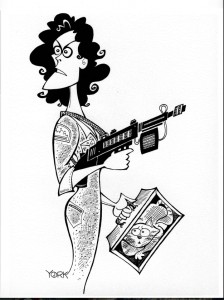
Many thanks to our guest blogger, Jeff York, a screenwriter, caricaturist, and the horror movie critic for the Chicago Examiner online. Jeff blogs about all kinds of movies @ his own website, The Establishing Shot. He lives in Chicago with his wife and two cats that they saved.
My name is Jeff York and I am a screenwriter, movie critic, and film blogger. I’m also a longtime fan of Blake Snyder. A big fan. I have all three of his books and they have helped my screenwriting immensely. I love Save the Cat!®, Save the Cat!® Goes to the Movies, and Save the Cat!® Strikes Back so much that I buy them as gifts for Christmas. Anyone who is a fan of film, whether they’re screenwriters or not, can learn so much from Blake’s informative take on the industry.
My favorite chapter from Save the Cat! Goes to the Movies is where Blake breaks down the structure of horror movies. And I love that he doesn’t call them horror movies but instead calls them “Monster in the House” movies. That term is really more inclusive as it covers everything from Jaws (1975) to The Hand That Rocks the Cradle (1992) to Paranormal Activity (2007).
The way Blake described it, a Monster in the House movie (or MITH) starts with “a powerful creature intent on eating the cast; an enclosed community into which the beast is let loose to apply his trade; and a third element: sin.” Blake went on to describe how the protagonist always invites the beast in through some sort of sinful act. In Fatal Attraction (1987), Michael Douglas’ sin is cheating on his wife with the “monster” man-eater played by Glenn Close. In Alien (1979), the greed of the corporation trying to transport the alien creature back to earth causes all the havoc. And in The Ring (2002), Naomi Watts is a “career first’ woman rather than an attentive mother — and that is what unwittingly invites danger into her family’s home.

Blake also got the name of his books from Sigourney Weaver’s intrepid Ripley character that saves the cat at the end of Alien. Blake suggested that a selfless act like this strengthens the hero in any movie. After all, who wouldn’t love a good guy who concerns himself/herself with a defenseless animal? And yet more and more MITH’s don’t follow Blake’s salient advice. If they had, we’d be experiencing better movies in the genre than we are at the moment. The MITH genre has grown awfully tired and clichéd partly because they have not heeded Blake’s advice to “save the cat.”
In fact, the killing of the family pet has unfortunately become so commonplace in MITH movies that it has become as unwelcome as the excesses of torture porn. Just look at the rampant pet killing on display in MITH’s these days: In this year’s remake of Straw Dogs, the movie’s redneck villains kill the couple’s innocent cat. In Fear (1996), psychotic boyfriend Mark Wahlberg and his thug friends cut the head off of Reese Witherspoon’s dog and shove it through the doggy door. In the remake of Willard (2003), a pet cat is attacked and eaten by the villainous pack of rats. In the remake of The Hills Have Eyes (2006), the family German shepherd is the mountain brood’s first victim. Even in a decent chiller like Sam Raimi’s Drag Me to Hell (2009), we still have to endure the heroine killing off her pet kitten as part of a voodoo ritual.
Blake Snyder knew, and so do you if you’re a pet owner, that pets are members of the family. They are loving, innocent creatures and the loss of the family cat or a dog is devastating. Too devastating for a MITH to ever truly recover from. But this fact seems lost on the filmmakers in Hollywood who think a pet’s death is nothing more than a practice kill for their villain. More and more, such events are stopping a film cold. It takes you out of a movie because of its awfulness. And none of the movies guilty of such egregious killings that I listed were big box-office hits.
Obviously the audiences are telling Hollywood something. And that something is save the cat.
BJ Markel
16 Comments
Leave a Reply Cancel reply
You must be logged in to post a comment.









Jeff’s hit the nail on the head. Not only is this true, but he’s insightful to make the connection with torture porn. Too many movies, starting with slasher films that manipulate the audience to identify with the killer rather than the victims, pander to our worst and darkest instincts and desires, such as torturing and killing animals, and raping, torturing, and murdering women. These so-called “horror movies” have cast aside the main point of the genre–facing your fears and sins and death, and overcoming them. Everyone should go see the prequel of The Thing this weekend and send a message that we want intelligent horror movies, not sadism!
Of course we know that Blake suggested our heroes save the cat to make them more likable, but Blake did mention that screenwriters can have the villain “Kill the cat” in order to make them seem more evil/villainous. I think it’s a matter of personal preference, but the villain killing the cat isn’t against the Blake Snyder story telling guidelines.
You mentioned Fatal Attraction. What about the bunny scene? Does that take you out of the movie, or by the point has it ‘earned’ the right to it?
I am a complete sap when it comes to pets dying in movies. Just for fun my brother and I built DoesTheDogDie.com (link is in my name above) so people can find out if a pet dies without getting completely spoiling the movie. It is not fun researching all those gruesome deaths, but somebody’s got to do it! Though I will admit sometimes I just trust the internet rather than watch something I know is going to be horrible.
This is Jeff York writing, the author of this essay. Thanks for your thoughts, for starters. And Mark is right. Far too many horror movies today show zero interest in the themes of a hero facing his fears. Most are merely content finding horrifically garish new ways to ‘off’ their victims. (Be they animal or human.) I dislike most horror franchises because the returning character is usually the villain and we should not really be showing up in the Cineplex to cheer on the likes of Freddy Kruger, Jason Voorhees or Michael Myers.
Don’t get me wrong, sometimes an animal’s death in a movie adds to the narrative. It did in “Fatal Attraction”, as awful as that scene was. It did in the horse head in the bed scene in “The Godfather.” But more often than not these days, pet killing scenes are there merely for cheap shocks or even laughs. And I applaud those who put together the site DoesTheDogDie.com as it provides a very valuable service to pet owners and movie fans alike.
Oh, and I just saw “The Thing” prequel. It’s very deftly done and quite smart. (Mark was right about that too.)
Well we always assume Cats and Dogs are good cats and dogs. Innocent cats and dogs. That assumption traps us into saving all cats all dogs. And accordingly kill a cat of dog without purpose is… not good. But sometimes we want jump up and down and yell YES when our Hero kills something that needs kill. So maybe we need a Kill the Snake for our heros in Monster In the House genre. Or may there is a bad cat or dog that needs killing. Yes cats and dogs can be killed if we can kill human other creatures. Think about it.
I don’t like movies where animals die. Now, in movies like Resident Evil I wasn’t too bothered because they were zombie-ish dogs. When I write my stories I purposely don’t put animals in them because as a reader and a viewer I always wonder what’s going to happen to the animal. When I’m watching MITH movies I would rather the body count go up than an animal die.
So glad the DoesTheDogDie.com site is out there. Wish I had visited it before I saw Straw Dogs last weekend. I already didn’t like the movie but when it got to that part I hated it. The rest of the movie didn’t matter to me anymore.
A perfect example of an STC moment is in the original Nightmare on Elm Street, where our main character says to her boyfriend “We’re here for Tina now, not ourselves.” My mind was totally blown when I saw that, it was clear from this point (which happens quite early in the movie) that this was our main character, and this is the one we should care about. Contrast that with the Nightmare remake where the main character has only ONE LINE in the first 30 minutes! Writers these days need to remember how to get the audience to care about the main character, rather than just marking her as the survivor.
I agree. The one I remember most is Jurrasic Park 2 when the T-rex’s only stateside kill was the little dog chained to it’s dog house. The image of the T-rex with the house hanging from it’s lip by the chain was just awful. Was that supposed to be funny? It just marked how helpless the poor thing was. He couldn’t even try to run. Discounting pets as less important is a terrible flaw. If they thought killing the dog and sparing the family inside was nice, they were wrong. Terminator 2 stopped themselves by removing the scene where they killed John’s dog. T2 was a big hit.
Crusader hit on a good point. I was a Freddy fan, but none of the sequels matched up. The STC moment I remember was Nancy tried to save the accused boyfriend by listening to him. The rest were just Robert Englund’s cliche quips. I didn’t care about any of the victims a bit. The novelty of knived finger tips didn’t last.
I agree with mark too, but it’s not sadism that drew me to Freddy. In the absence of a real hero the audience needs to root for something. So it becomes about the writer’s method. We root for the creativity of the kill.
But when we see real story with heros and villians like Hand that Rocks the cradle, Misery, and Pacific heights we grow up. Slasher flicks are subject to ridicule now.
But Jeff did you forget when it’s okay to root for the villian? A good STC lets us at least not want them killed or prisoned indefinately even if we hate what they are doing, we feel for them. “Hunting Humans” had me stumped but we are the CATS and pets weren’t diregaurded but one dog dies.
The only good movies in the whole Nightmare series are 1,3, and 7. Interestingly, these are the ones written and directed by Wes Craven (someone who knows very well how to get us interested in the main character) and stared Heather Langencamp (the character we all know and love). Those movies were good because they were about her, not about Freddy. I think that’s why the Scream series (one again, with Wes Craven) is so enjoyable. It’s not about a returning killer (technically, there is none since Ghostface is a persona taken on by whoever wants to be the killer in the movie) it’s about Sidney Prescott, who in my opinion, is the best horror movie heroine I have ever seen.
Great comments here!
Indeed there are times that a killed pet in a movie can add to the drama and not take you out of the film or seem gratuitous. Still, I’d argue a better screenwriter would be able to showcase his or her villain without having to resort to such obvious ploys that offend so. But it can be done effectively and not cause irreparable damage to the movie-going experience.
Great example, Susan Modregon, of an egregious killing being the T-Rex chomping on the pet dog in the doghouse in JURASSIC PARK 2. That kind of example is sloppy humor at best. But so much of that movie was terrible anyway, so perhaps we shouldn’t be surprised.
My biggest issue is why killing pets now seems so prevalent in movies. It’s so par for the course that it’s become a hoary cliche. How did that happen? Are screenwriters that lazy? Do they think they’re being snarky? Or cool? Or have they had such limited experiences in the real world that all they’re doing is recycling cliches from movies they try to imitate? Perhaps they’ve never owned a pet. But no matter what the reason, it’s all making for a lot of really crappy thrillers and horror movies that are impeding the genres.
Jeff – Do you think the reason for this disturbing trend could be that screenwriters are no longer writing for a predominately American audience?
In America our pets are highly valued members of the family, but this isn’t the case in other parts of the world. Is this an effort to cater to a worldwide box office? Just a question. I am way, way, way outside Hollywood and the movie industry, but it is my impression from what I’ve read that domestic box office numbers are on the decline. Any thoughts?
Regardless, I feel good storytelling is what puts butts in the seats, and this rarely, in my opinion, includes killing the family pet. No dramatic necessity and not very creative.
In recent years, I have found this to be a storytelling taboo that more and more makes its way into movies, and it is troublesome. I worry that it is a sign of an unhealthy culture that places little value on innocence and takes pleasure or finds entertainment in cruelty.
RE: Heidi’s comments, It’s a good point about other cultures, but if we as Americans see a movie like Mulan, we can still relate to certain things even if it isn’t our culture. It’s human for all of us to find companionship with animals, whatever kind they are. Even in Vietnam where they eat dogs, I’m sure there are other animals they consider family. In India they may see a dog killed in an american movie and think what if the T-rex ate my cow? It goes back to what Blake said, Is it Primal? We don’t have to own a cow to understand. We all love our pets and want to protect them and hurt when their lost.
Thanks for that aknowledgement Jeff. I personally liked the sequels for Jurrasic Park for the most part. Not as good as the first, but I felt the stories were good and I cared about the cast. I hope that doesn’t mean I can’t tell good story from bad. MITH isn’t my strongest forte, I’m more like Blake with Family and Fantasy, but I’ve had some ideas towards MITH, and I certainly hope to have better said of my work on anything I put out there when I become a screenwiter.
btw Jeff, not all the screenwriters today have been going the bad route. I applauded the writers when I saw the recent Sorcerer’s Apprentice movie when they turned the dogs back into paper pictures before the train hit. That is a perfect example to Robert Benedetti in how it’s not always necessary to kill EVEN THE BAD DOGS! Nobody was disappointed to see the wolves turned to puppies rather than slaughtered and MOST CERTAINLY nobody wanted to see innocent puppies bloodied by a train! Another great OLD example was the opening of TRUE LIES when the gaurd dogs attacked Arnold. He didn’t blast or blow them up. He knocked their heads together in mid jump. BRILLIANT! We could cheer, applaud, and laugh cuz they didn’t get hurt, just stunned. We appreciate these dogs are just doing the bidding of their masters. The masters are the bad guys, not the dogs. Let that be a lesson to Robert before you start killing dogs.
The Saw franchise was a success because the movies were set apart from other horror movies in a unique way a serial killer who never killed anyone.
horror movies aren’t what they used to be when i was growing up i was given a choice as a kid i could go out and practice sam hain or i could stay home with my mom and baby brother and rent a bunch of early to mid or even late 80’s mid 80’s or even late 70’s era horror movies and watch them with my mom the original hills have eye’s the original dawn and night of the living dead the original day of the dead and friday the 13th and of course halloween so yeah i did that but back then they didn’t torture animals i know in halloween he killed the dog aside from that total dick move it was evident that my mom trusted me to watch those movies at such a young age i also read and still own my stephen king novels see y’a